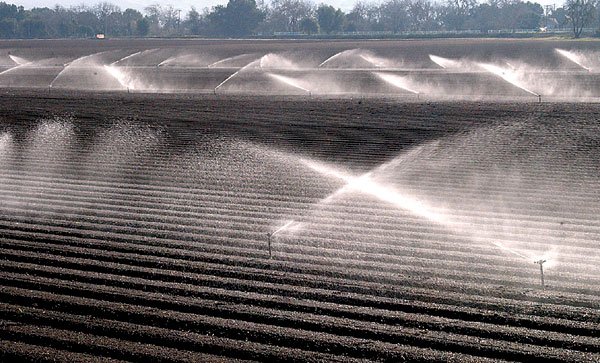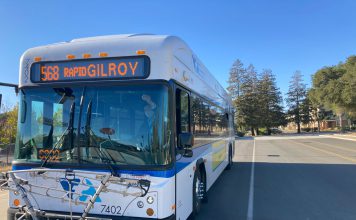Gilroy – When he was first contacted about watering his fields
with recycled water, Tom Obata was skeptical. Recycled, after all,
is a euphemism for
”
waste
”
and Obata grows food at his 1,200-acre east Gilroy farm.
Gilroy – When he was first contacted about watering his fields with recycled water, Tom Obata was skeptical. Recycled, after all, is a euphemism for “waste” and Obata grows food at his 1,200-acre east Gilroy farm.
“I was concerned when I was first approached, but once I saw the tests results, my concerns were erased.” Obata said Wednesday of his dealings with the South County Regional Water Authority, which suggested that Obata used the waste water.
So for the last five years, Obata Farms has met a fifth of its irrigation needs with recycled water and saved a bundle in the process. Now, Obata wants more and the SCRWA will soon be primed to it give to him.
In May, SCRWA will begin work on a reservoir and pump station, the first phase of a 10-year project that will dramatically boost its capacity to filter and supply reclaimed waste water. Capacity will double by the summer of 2006, and by 2020 water officials hope that recycling will account for 10 percent of all the water used in Santa Clara County.
That’s good news not only for Obata Farms and other users of the water, but the area’s ground water as well. Every gallon of waste water is one gallon less that comes from the ground.
“As water supplies get tighter and tighter, people will be looking for where water is going to come from,” said Jim Gasser, staff engineer for SCRWA.
Reclaimed water is not drinkable. During the recycling process, it is screened and oxidized, then chlorinated and dechlorinated. The process leaves it with trace amounts of ammonia and nitrates.
But it is sufficiently clean for other uses, including most crops. In addition to Obata Farms, major users in Gilroy include Eagle Ridge Golf Club, Christmas Hill Park and the Calpine-Gilroy Energy Center.
The water treated at SCRWA facilities comes from Gilroy and Morgan Hill, water Gasser called “relatively unnoxious stuff,” free of most heavy metals and perchlorate.
“The water is all from potable sources so any small amounts of perchlorate are removed in the treatment process,” Gasser said.
Obata grows bell peppers, broccoli, onions, spinach and green beans. “I’ve had no complaints from processors I grow for or my employees,” he said.
And he prefers irrigating with reclaimed water because it’s pressurized. Obata estimated that he saves at least $50 an acre-foot in diesel and electricity costs for water that he doesn’t have to pump from wells.
He uses about 6,000 acre-feet of water a year, about 1,100 of which are recycled. In the summer of 2006, Obata will be able to water with an additional 1,300 acre-feet of reclaimed water.
An acre-foot is equal to 326,000 gallons, or the amount of water that will fill an area the size of a football field to a depth of one foot, or enough to supply a family of five for one year.
But not every farming operation can use reclaimed water. Obata’s fields happen to border the SCRWA’s treatment plant and the pipeline cuts through his farm. Future pipelines will slice through agricultural land between the SCRWA plant and the Pajaro River.
The first phase of the project, officially called the South County Recycled Water Master Plan, will cost $4.7 million, $3.2 of which will come from the Santa Clara Valley Water District. The entire project is expected to cost about $28 million, funded jointly by the Water District and SCRWA.
“Water recycling does require a large capital investment,” said Tracy Hemmeter, a senior project with the Water District, “but it’s an investment that improves the viability and reliability of our water supply.”
Gasser said that existing customers warrant immediately raising the supply from 711 acre-feet per year to 1,566. By the end of the project, capacity should reach 3,150 acre-feet.
Kent Robertson, a spokesman for Calpine, said that the electricity provider prefers to use recycled water in its cooling towers.
We’ll take it,” he said of the increased supply. “Given the appetite for water that a large power plant has, we can take an environmental liability and turn it into an asset.”
The challenge for SCRWA and the Water District will be finding new customers to justify the $28 million price tag for the entire project. Improvement plans include miles of additional and retrofitted pipelines, and new storage and pumping facilities. Water officials have identified a score of potential new customers in Morgan Hill and expect that new developments at Glen Loma Ranch, Eagle Ridge and Hecker Pass will boost demand even further.
“We’re not so much creating demand as meeting it,” Gasser said. “We’re trying to find other potential users for the future. We know they’re out there.”













